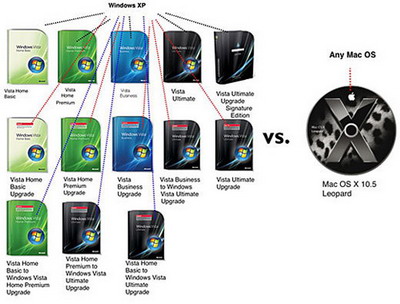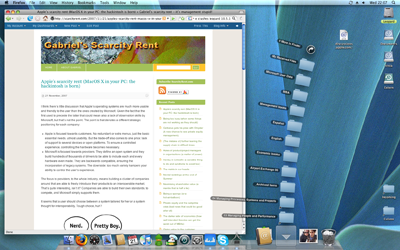Vista has not accomplished its expectations. Albeit more than 140 million copies sold, that only represents around 13% of the installed base. And if you take into account that Vista has been around since november 2006 and an average lifespan of five years for any computer, only because of natural growth that figure should be around 20%. What’s happening?
When a company has such a great market share as Microsoft, and a killer and omnipresent product like Windows, it wouldn’t be fair to say that those figures mean trouble. Not really, only unfulfiled expectations, that’s all.
But users are not massively upgrading to Vista. Many prefer their new computers with XP (and still get counted as new Vista licensees) because it’s simpler, faster, and you already know your way around. I myself like the aqua, sorry aero, look in Vista, but still struggle to find my way to simple things. I’d rather use a simpler system: I get tired of so many questions and confirmations and having to navigate tortuous paths.
Simplicity gets its reward in speed. Ask any Linux geek and he will tell you how he manages without lots of small utilities incorporated in your software that you use daily. The good thing is that he also manages without hundreds of utilities that you seldom or never use, and without hundreds more that you never knew they existed and, if you ever had needed them, you wouldn’t have even sought. (Do you really know how to insert an horisontal line in Microsoft Word or how to query an ODBC source in Windows?)
Then, there’s us, people that use MacOS. A sometimes despised and bashed minority (around 3%) that happens to be growing above average with a dangerous tendency to be self-conscious. In a mass consumption society, isn’t it great to be special in something? More stable than Windows, more usable, a better user experience (yes, that is completely subjective, but believe me in this one) but still not bomb-proof in its latest version: Leopard. And more visible than ever because of iPods, iPhones and, of course, the incumbent’s spoofs.
But, following the initial reasoning, which are the strategies behind the operating systems? Which should be next move? Apple has recently uncovered a few words about their new version of MacOS: from Leopard to Snow Leopard. Doesn’t sound very different, does it? What’s behind it and why is it important? It’s not easy to deny that Apple knows a lot about emerging trends that tend to be imitated by the rest of the market.
I’ve drawn the following model thinking about operating systems in two axis:
- on the horizontal axis the sophistication of the operating system, measured in terms of “eye candy”, as it is easy to observe and doesn’t focus on the utility of that eye candy (that would increase the analysis’ complexity and introduce a lot of interpretation), but it’s obviously correlated with the utilities offered to the user.
- on the vertical axis is the complexity and size of the code what counts: the system weight.

First of all, the dangerous zone is on the top level: heavy systems. Heavy systems tend to be unstable, usually because they build on foundations laid out many years ago by legacy systems that don’t exist anymore but that they need to preserve. This is the case increasingly both by Windows and MacOS: the first because it has compatibility with a sheer list of devices and still with good old MSDOS, the second because, albeit being much more selective with hardware, still hasn’t recovered from the trauma of having two very distinct CPU platforms: the PowerPC and the Intel platform. Vista still is far higher in this classifications making a very heavy system, to the point that requires the latest hardware to fully function while still being compatible with everything else. That’s why many prefer XP.
The massive side for an operating system is not that good either. XP was clearly short of functionality, while with Vista the effort has been made to try to compensate, but jumping too far away, adding cumbersomeness to the menu. Vista is only a street away of being annoying, and that’s another reason to still prefer XP. In any case it’s also a proof that with XP you’re going to miss things too.
MacOS stays in a comfortable middle position. Still, Leopard increased functionality and usability, as well as eye-candy, but paying a price for it: increased system sophistication and weight. That means, of course, instability issues.
Linux users sit in a comfortable corner table: a simpler system that is lighter than anything else, with good and bad consequences.
Where is the future going to be?
This is the part that is supposed to be explained in Nostradamus’ prophecies, but I think I have a clue to offer. Many Vista users are still downgrading to XP, and there must be a reason for that: the seeking of simplicity. We need more stable operating systems, not nicer ones. Don’t get me wrong, we like eye candy, but we are ready to trade some off in exchange for better performance. Windows should aim back, somewhere in between Vista and XP, going down in the stability road… and down the chart back to the safe green zone, still losing some screens and complexity in its way.
That’s what Snow Leopard is all about. The same animal, only changed by a couple of colours, but ready to live in a much hostile environment. Trimming the OS, making it more hardware selective, only optimised for the newest hardware platforms. No human-machine interface overhaul but a lot of kernel and essential applications rewriting. That’s, in my humble opinion, the way to go. And the way Microsoft should follow too.
Because, when with a laptop, energy consumption depends on CPU consumption, and thus in the cleanliness of the code, and the megabytes taken by programs to run. After all, those bytes need to be read from the hard disk, paged in and out of the memory, and can potentially make your computer run out of fuel faster.
Taken from Roughly Drafted, a web you cannot miss if you want to know more about Apple, this is what the apple folks have been doing to the Snow Leopard basic programs:

Interesting backoffice work, don’t you think? 🙂







 Why is people downgrading from Vista? It’s not because it’s ugly, it is not ugly enough for that, and XP wasn’t the most handsome kid on the block either. People are trying to avoid vista because it requires too much hardware, because takes too much resources to run, because it’s not as snappy as it should be.Think of it from the personal computer cluster’s viewpoint: additional requirements from OSes mean more opportunities to sell more advanced hardware, and thus a growing market. The more sophisticated OSes become, the more complex hardware is needed. And the different companies are, of course, happy to indulge and sell.But that’s not what users want. There are no new necessities covered. Applications are fancier, yes, but there are no new killer applications. In fact I still have to see an application that makes full use of Vista’s new graphics engine. Everything could still be done from XP, no transparent frames, true, but who cares?After seeing Vista, people still prefer to focus their hardware on a better working machine, not on a better looking but buggier one. And they look the other way round… to XP and sometimes Apple.That’s where Apple’s new market share comes from. In evolving their Mac OS X system they have not used the extra power inherited by Moore’s law to rejoice in extra-sophisticated graphics and a huge coverage of legacy systems. Instead they have used it to get snappier applications, providing a secure and limited environment, even excluding their oldest hardware from compatibility. Once their compatible hardware (yes, all of it PC compatible hardware) has been short-listed, they have focused on making it work better.And then they have favoured usability over trendiness (without forgetting the latter). Simplicity over a spree of hidden options, users’ needs over hardware providers’ needs.
Why is people downgrading from Vista? It’s not because it’s ugly, it is not ugly enough for that, and XP wasn’t the most handsome kid on the block either. People are trying to avoid vista because it requires too much hardware, because takes too much resources to run, because it’s not as snappy as it should be.Think of it from the personal computer cluster’s viewpoint: additional requirements from OSes mean more opportunities to sell more advanced hardware, and thus a growing market. The more sophisticated OSes become, the more complex hardware is needed. And the different companies are, of course, happy to indulge and sell.But that’s not what users want. There are no new necessities covered. Applications are fancier, yes, but there are no new killer applications. In fact I still have to see an application that makes full use of Vista’s new graphics engine. Everything could still be done from XP, no transparent frames, true, but who cares?After seeing Vista, people still prefer to focus their hardware on a better working machine, not on a better looking but buggier one. And they look the other way round… to XP and sometimes Apple.That’s where Apple’s new market share comes from. In evolving their Mac OS X system they have not used the extra power inherited by Moore’s law to rejoice in extra-sophisticated graphics and a huge coverage of legacy systems. Instead they have used it to get snappier applications, providing a secure and limited environment, even excluding their oldest hardware from compatibility. Once their compatible hardware (yes, all of it PC compatible hardware) has been short-listed, they have focused on making it work better.And then they have favoured usability over trendiness (without forgetting the latter). Simplicity over a spree of hidden options, users’ needs over hardware providers’ needs. But that’s not the only thing going around.And there’s still another trend going on here: from more powerful portable computers to simple ones (that are still very sophisticated by the way) but focus on doing simpler things and rely on other machines and network capabilities. We will no longer need that huge hard drive in our laptop when we will be able to store and synchronise our files on-line. Or, as the MacBook Air does, we don’t need to have a DVD unit in our laptop if we are able to access other’s people DVD drives.And sometimes, as gadgets like Blackberrys, iPhones et al have demonstrated, we can do most of the things we are requesting from our laptops if we can have better screens, better connectivity and better input methods.Or with network shared utilities and storage, as well as web-based applications (look out for some Google office hardware soon). Those web applications will increasingly have the ability of working off-line and syncing when needed. That will mean less reliance on your “own” computer and easier usability of both shared and simpler devices.
But that’s not the only thing going around.And there’s still another trend going on here: from more powerful portable computers to simple ones (that are still very sophisticated by the way) but focus on doing simpler things and rely on other machines and network capabilities. We will no longer need that huge hard drive in our laptop when we will be able to store and synchronise our files on-line. Or, as the MacBook Air does, we don’t need to have a DVD unit in our laptop if we are able to access other’s people DVD drives.And sometimes, as gadgets like Blackberrys, iPhones et al have demonstrated, we can do most of the things we are requesting from our laptops if we can have better screens, better connectivity and better input methods.Or with network shared utilities and storage, as well as web-based applications (look out for some Google office hardware soon). Those web applications will increasingly have the ability of working off-line and syncing when needed. That will mean less reliance on your “own” computer and easier usability of both shared and simpler devices. That’s three dilemmas identified in this post:
That’s three dilemmas identified in this post: Apple, without being that brilliant (Steve Jobs *is* brilliant indeed), is doing much better by comparison… better enough to reclaim part of the market share that the incumbent is going to lose. Try a Mac OS X and tell me 🙂
Apple, without being that brilliant (Steve Jobs *is* brilliant indeed), is doing much better by comparison… better enough to reclaim part of the market share that the incumbent is going to lose. Try a Mac OS X and tell me 🙂 Simplified like that one would say “let’s choose a system designed solely for the users”. But that’s not quite true. Both systems have users in mind, only a divergent focus. But a focus towards the industry means being able to access a pool of competing hardware. And that means lower prices… ain’t that nice for the user? Maybe the focus wasn’t the user, but she is directly benefited of having an interoperable and open hardware industry.That’s why the nerds simply won.But history makes strange turns. And Apple has changed a lot through the times. Two important swerves:
Simplified like that one would say “let’s choose a system designed solely for the users”. But that’s not quite true. Both systems have users in mind, only a divergent focus. But a focus towards the industry means being able to access a pool of competing hardware. And that means lower prices… ain’t that nice for the user? Maybe the focus wasn’t the user, but she is directly benefited of having an interoperable and open hardware industry.That’s why the nerds simply won.But history makes strange turns. And Apple has changed a lot through the times. Two important swerves: